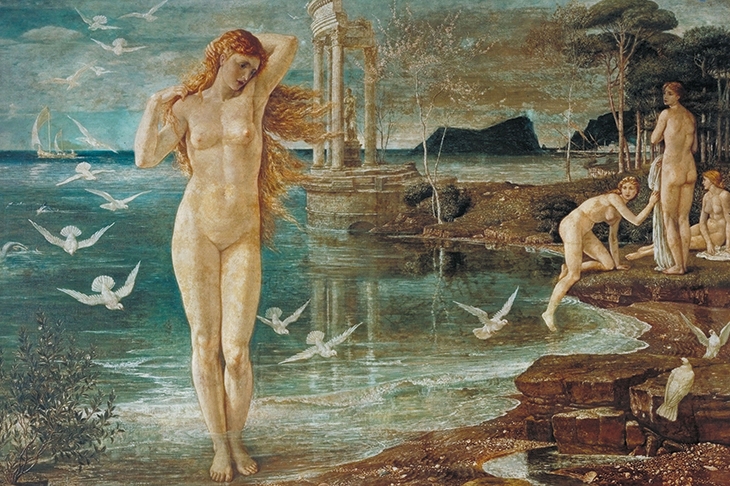‘There is only one thing worse than homosexual art,’ the painter Patrick Procktor was once heard to declare at a private view in the 1960s. ‘And that’s heterosexual art.’ It would have been intriguing to hear his views on Queer British Art at Tate Britain. All the more so since it includes several of his own works, including a fine line-drawing study of the playwright Joe Orton, completely naked except for his socks — which he kept on because he felt they were sexy — and reclining somewhat in the manner of Manet’s Olympia.
In fact, many of those included might have had reservations — Oscar Wilde, for example, one of whose characters observed, ‘The only artists I have ever known who are personally delightful are bad artists.’ There are quite a few of those included here. Then again, strictly speaking Queer British Art is not about art at all, but defined by law, and those who fell foul of it.
In other words, it’s concerned with a clandestine and persecuted group. Its para-meters are the abolition of the death penalty for sodomy in 1861 and the legalisation of sexual intercourse between consenting adults in 1967 (Oscar’s fate is grimly documented by a cell door from Reading Gaol).
The result, from the artistic point of view, is a lot of promiscuous mingling of the good, the indifferent and the simply awful (though sometimes, as in the case of Glyn Philpot’s paintings, also quite fun). Frankly dreadful items such as Walter Crane’s enormous, pallid, silly ‘Renaissance of Venus’ (1877) get in for the sake of a good story. Apparently, on first seeing this canvas Lord Leighton exclaimed, ‘But my dear fellow, that is not Aphrodite — that is Alessandro!’ He meant that the body was that of Alessandro di Marco, a successful male artists’ model.
The received explanation for this — if the picture really was painted from life rather than being simply a blend of Botticelli and whimsy — is that Crane’s wife forbade him from using female models. The catalogue, however, prefers to interpret it as a case of gender fluidity, quoting with approval the comment of the painter W. Graham Robertson on Leighton’s remark: ‘Still, she was a fine, upstanding slip of a boy.’
Fluidity of gender is, naturally, a hot topic in queer studies — an academic discipline as abstruse as particle physics, and discussed in equally impenetrable jargon. It is presumably because of complex equations worked out by trained queer scholars that pictures such as Cecile Walton’s ‘Romance’ (1920) — a semi-nude self-portrait of the artist as a young mother with her two children — are included. It comes in a section headed, rather broadly, ‘Defying Convention’.
There are moments, while walking around, when you begin to wonder whether there is any clear distinction between queer British art and British art, tout court. Indeed the non-British sculptor-painter Alberto Giacometti had the same thought, according to Lucian Freud. ‘He told me he had decided to come and live in London, “…et je deviendrai un pédéraste”. Almost all my friends at that time were queer, and he had decided that that was the life!’
Freud is not included in the exhibition, but many of his circle from the Forties and Fifties are — John Craxton, John Minton, Francis Bacon. It is easy to imagine Bacon’s response to being seen in this company, aesthetically. He was a famously savage critic — one friend gave up painting in despair after Bacon’s hilariously scathing reaction to his work.
He would probably have been equally entertaining if let loose on the audio guide to Queer British Art— but perhaps unfairly so. There are some fine pictures here and there — by the neglected Edward Burra, for example, and the almost forgotten Ethel Sands. The photographs, however, tend to catch the eye more than the paintings — whether camp and fantastic, such as Cecil Beaton’s ‘Stephen Tennant as Prince Charming’ (1927), or poignant like John Deakin’s frayed print of the two Roberts, Colquhoun and MacBryde, asleep (or passed out) in each other’s arms, c.1953.
Turning to the two stars of the show, there is much better Hockney on display in his triumphant retrospective and the Bacons are also far from his best. It’s a shame that Tate couldn’t get the latter’s ‘Two Figures’ (1953) — based on Muybridge’s photographs of naked wrestlers and informally known as ‘The Buggers’ — which is surely one of the truly great post-war British paintings. It hung for many years on Freud’s bedroom wall. Francis, he recalled, liked to imagine that he was the one underneath.
Those more interested in visual delight than in social history — albeit touching and amusing — might like the new installation ‘Forms in Space …by Light (in Time)’ by Cerith Wyn Evans in the grand Duveen Galleries upstairs. It consists, in effect, of illuminated neon tubes that draw in the air above your head, producing an effect a little like a skein of vapour trails in the sky. It’s free, fresh, energising and altogether lovely.






Comments